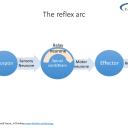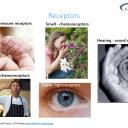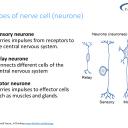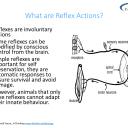Reflexes
 Innate behaviour is not dependent on the environment and can be seen in new born animals before there has been any chance of learning. This behaviour is largely the result of reflex arcs built from sensory and motor neurones. This activity introduces the pain withdrawal reflex and other involuntary responses in humans.
Innate behaviour is not dependent on the environment and can be seen in new born animals before there has been any chance of learning. This behaviour is largely the result of reflex arcs built from sensory and motor neurones. This activity introduces the pain withdrawal reflex and other involuntary responses in humans.
Lesson Description
Guiding Questions
Which of these images shows innate behaviour?
What is the difference between innate and learned behaviour?
Activity 1 - Innate behaviour and the reflex arc
Innate behaviour is a type of behaviour which does not have to be learned. It is present in organisms raised in isolation and performed in the same way by each individual. Sometimes it occurs organisms in the form of reflexes or fixed action patterns and also as short sequences of actions in response to a stimulus.
- Introduce reflexes using the slides below and describe the reflex arc and the role of the neurones involved.
Activity 2 - Relating the reflex arc to the pain withdrawal reflex
This animation illustrates the different parts of a reflex arc. This particular example is known as the pain withdrawal reflex.
Identify each part of the process.
Make a bullet point list of the steps in the process using ![]() Reflex arc worksheet. shown below
Reflex arc worksheet. shown below
Activity 3 - Invertebrate behaviour experiments
Students can analyse the innate behaviour of invertebrates in a wide range of experiments.
The skill of analysis of data from these experiments is important.
Usually innate behaviour gives a survival advantage to the animals. Analyse the experiment shown in the video below and try to work out how this behaviour might increase the chances of survival or reproduction of these woodlice.
Thanks to AHSBiology for this really useful video.
Record Data every 30 seconds for 10 minutes.
The video goes faster between each 30 second intervals - so the whole experiment takes just 5 minutes.
There are ten animals in total in the choice chamber.
Sample results to save time (this data only covers the first half of the video)
| Time | Number of woodlice in the dark | Number of woodlice in the light |
|---|---|---|
| 10:25:00 | 5 | 5 |
| 10:25:30 | 6 | 4 |
| 10:26:00 | 4 | 6 |
| 10:26:30 | 3 | 7 |
| 10:27:00 | 4 | 6 |
| 10:27:30 | 5 | 5 |
| 10:28:00 | 3 | 7 |
| 10:28:30 | 5 | 5 |
| 10:29:00 | 4 | 6 |
| 10:29:30 | 4 | 6 |
| TOTAL | 43 | 57 |
| Average | 4.3 | 5.7 |
Conclusion
- What can you say about the distribution of the woodlice in each chamber? ........................................................................................... ...................................................................................
- Does it provide strong evidence of any innate behaviour?
........................................................................................... ................................................................................... - Did you notice the woodlice stay near the edges of the chamber, and often touch each other? This is called "thigmo-kinetic" behaviour. When woodlice are in contact with others or with a rough surface their movement slows down. Suggest how this could help the woodlice to survive?
.......................................................................................... ...................................................................................
........................................................................................... ...................................................................................
........................................................................................... ...................................................................................
Teacher's notes
Guiding questions
The images show a spider's web, and 'pill bug' rolled into a ball for safety, a human baby grasp reflex and a wren singing. Birdsong is the only behaviour which is not completely innate. Although birds can sing without learning there are many examples of birds learning parts of their song from others.
- Related reflex arc structure to the pain withdrawal reflex of the hand.
- Ability to label a diagram of the pain withdrawal reflex, including a receptor cell, sensory neuron, relay neuron, motor neuron and effector.
Activity 1
This set of slides illustrates the components of the reflex arc. They could be used by students alone or presented to a class to stimulate discussion and even note taking.
Activity 2
The animated gif shows the components of a reflex arc in a simple way. Students can use the worksheet to make notes of the steps ina reflex response. The worksheet includes a couple of additional questions which point out that the processes in involuntary and also that the brain can inhibit some reflexes.
Activity 3
The experiment illustrates the type of choice chamber experiment which is possible to provide quantitative evidence of innate behaviour. This example doesn't provide good quantitative evidence of innate behaviour, but there is an opportunity to see that woodlice most often stay touching the edge of the chamber or each other.
This is a behaviour called thigmokinesis which is thought to be important ecologically, and it helps the animals to retain moisture, and possibly to avoid predation.

 IB Docs (2) Team
IB Docs (2) Team













